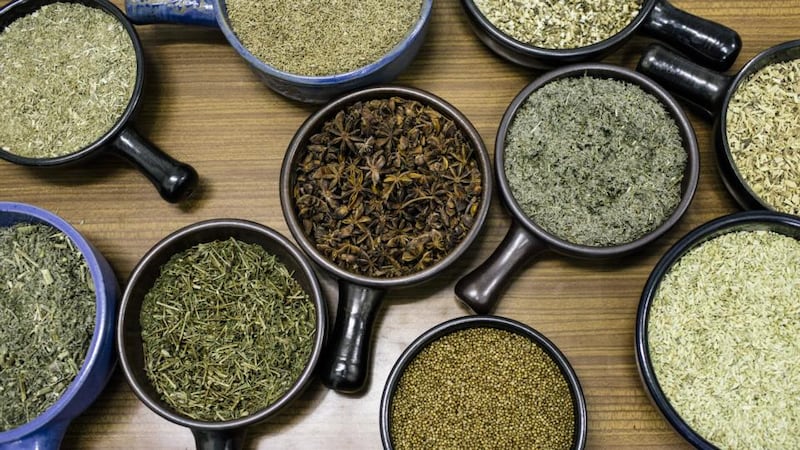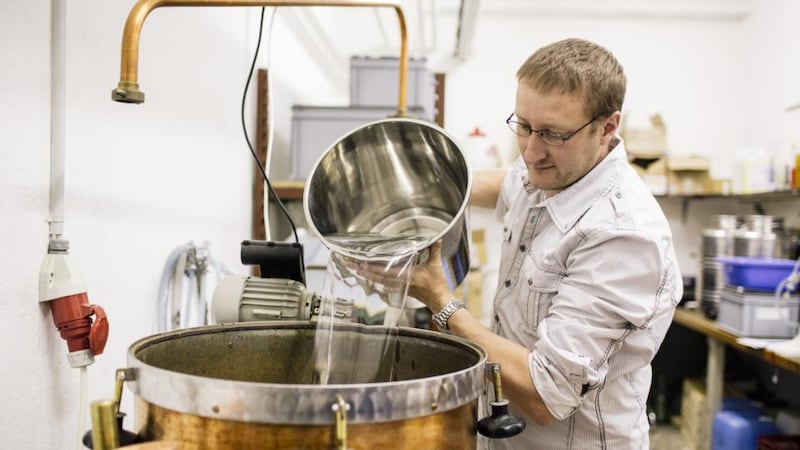Sunbeams shot through the forest, lighting up the wispy fog on the path ahead. For over an hour I’d been walking up the mountain trail alone, marching to the off-kilter orchestras of Swiss cowbells ringing their dull symphonies in nearby meadows. For several minutes, I was certain that I had lost my way. But eventually I spotted a sign for the goal I was seeking: La Fontaine Froide, it said, was somewhere up ahead.
A "cold fountain" wasn't the only reason I'd come to this tiny Francophone valley in northwest Switzerland, just across the border from the Franche-Comté province of eastern France. I was looking for the fountain because its chilly water was said to be ideal for diluting – or "troubling," as locals put it – a glass of absinthe, the area's traditional alcoholic beverage.
An intense spirit flavoured with a bouquet of powerful herbs, absinthe had been the favourite drink of impressionist painters, romantic poets and the bons vivants of the belle epoque before being banned around Europe on the eve of the first World War. There was supposed to be a bottle of the good stuff, and a glass, waiting to reward any visitor who survived the long hike up the mountain.


As I approached, I heard the gentle dribble of icy water. Just off the path stood a long basin carved out of a hollowed-out log, into which a stream flowed from a spigot overgrown with moss, almost the same colour as the traditional green version of the drink, absinthe verte. A trail marker noted that I had reached 1,126 metres (3,694ft), and I felt the relief of having achieved my goal. But the bottle promised was nowhere to be seen – spirited off, I imagined, by the Green Fairy herself, or some other mythical inhabitant of the Val-de-Travers.
“You’re in the valley of absinthe, in the place where it was born,” said Claude-Alain Bugnon, the distiller of La Clandestine and other cult absinthes, as he poured me another shot and topped it off with chilled water after I told him about my trip to the fountain the next day.
The unspoken lesson: It was foolish to hike for hours in search of something as ubiquitous as absinthe in the Val-de-Travers, where the drink known as la Fée Verte, or the Green Fairy, had been distilled for centuries. But the trek through the forests and fields had given me a deep appreciation for the landscape that had produced one of the world’s most celebrated – and, at one time, reviled – beverages. Naturally, it had also helped me work up quite a thirst.
That thirst had been initially piqued just a few weeks earlier. A friend in Prague had started hosting upscale absinthe tastings at a bar there last summer, including several of the new – or renewed – versions coming out of France and Switzerland. Although both had banned it about 100 years ago, following widespread panic about its hallucinogenic and deleterious effects, production was legalised again in Switzerland in 2005, followed by France in 2011.
These days, people no longer seemed to fear the Green Fairy, and the growing popularity of cheap, inauthentic absinthes from countries where the drink had never been banned – primarily the Czech Republic – put pressure on authorities to lift the ban in absinthe's traditional homelands.
After sitting in on one of my friend’s tastings, I found myself unable to stop thinking about the complexity of the drink’s anise aromas and the starkness of the bitter herbs on the tongue, and was disappointed that I couldn’t find anything similar, not even at the city’s best bottle shops. (And although I certainly didn’t hallucinate, I missed the pleasant dreaminess the drink seemed to evoke.)
As I began reading more about absinthe, I discovered that some of the most highly praised versions came from the Val-de-Travers. Indeed, it turned out the area and the nearby province in France even had something called la route de l'absinthe, a semi-organised list of attractions related to the drink: distilleries, museums, restaurants and destinations like the Fontaine Froide.
Two weeks later, I was watching the azure waters of Lac Léman flash by on a high-speed train from Geneva Airport to Neuchâtel, where I would transfer to a local train for the short final leg. If good absinthe couldn't come to me, I simply had to hit the Swiss-French absinthe trail.
The view into the Val-de-Travers gave me a taste of the area’s remote ruggedness. On either side of the tracks, pine-covered mountains soared up into the clouds, their tops invisible through the grey. The journey from Neuchâtel took only a half-hour, but we passed through multiple dark tunnels cut through the rock. Above the tracks, nets of heavy cables were set up to catch any falling boulders.
It was an ideal landscape, I imagined, for bootleggers and smugglers, with hidden paths climbing up to high plateaus overlooking the valley, like the panoramic cliff called the Creux du Van that I'd climbed after my unsuccessful hike up to the Fontaine Froide. And indeed, as Bugnon explained when I met him in his distillery in Couvet, bootlegging was a reason absinthe had returned so quickly to the region after it was re-legalised. With a population of only 10,000, there were now more than 20 legal distillers of absinthe in the Val-de-Travers, he said, and many more still operating as "clandestins", or illegal producers.
It wasn't just that the Val-de-Travers enjoyed a lengthy tradition of bootlegging: Many of the most important ingredients in absinthe came from the area. In particular, its namesake ingredient, grand wormwood – Artemesia absinthum in Latin and simply called "absinthe" in French – might have been found all over Europe, but the type that grew in the Val-de-Travers and nearby Franche-Comté was said to be vastly superior. Other herbs used in the drink, like lemon balm and lesser wormwood, were also sourced here. But if the drink was illegal for almost 100 years, I wondered, how did distillers manage to keep producing it?
The next day I walked along the Areuse river from my hotel in Couvet, the historic hometown of absinthe, to the village of Môtiers 40 minutes away. The region’s largest absinthe brand, Kübler, is located there, as are several other distillers. As I approached Môtiers, a stone church seemed to rise up to greet me. When I got closer I noticed it was covered with scrawled-on dates – “1702” and “1714” – and other graffiti from the Enlightenment era.
It wasn't long after the graffiti appeared on the church walls that absinthe started to be produced in the Val-de-Travers, explained Christophe Racine, a former druggist and onetime bootlegger who is now a legal distiller of La Fine absinthe, and the owner of an absinthe boutique in Môtiers.
Far from being a dark age, he said the ban (l'interdiction in French) was highly beneficial for the drink. "I think of the years of interdiction as the years of research and development," he said. "After the war, many herbs that were expensive, like star anise and coriander, became very cheap. The recipes improved a lot during those years. When the French firms started making absinthe again, they often returned to their original recipes. But the Swiss clandestins had developed their recipes and had started making absinthes that were really aromatic."
The ban had probably also contributed to the development of Switzerland's colourless version of the drink, called either blanche (white), or bleue, although it remains as clear as water. While traditional absinthe verte is known for its deep, brownish-green hue, absinthe bleue is made without the final step of colouration, saving production time and allowing it to be passed off as a normal spirit, potentially right under the noses of the police. And if it wasn't sold this way, it often went by a code name.
"When we were kids, if someone telephoned and asked if we had absinthe, we had to say no," recalled Françoise Gomes-Bovet as she poured a shot of a rich, almost fruity absinthe bleue in the tasting room of her father's distillery, Bovet, just around the corner from Racine's boutique. "But if they asked if we had some lapin for sale – rabbit meat – we'd say yes, come on by. And then we would sell them absinthe."
Although was born in Switzerland, the drink had come of age just across the border. One of the biggest distillers, Pernod, had started in Couvet before moving production to the French town of Pontarlier, after which it inspired a wave of imitators. By the end of the 19th century, Pontarlier was home to some 75 absinthe distilleries.
Travelling there, I met American author, Scott MacDonald, who was signing copies of his book, Absinthe Antiques: a Collection From la Belle Époque, when I asked if he could describe the difference between the two countries.
“The French absinthes tend to be darker and more mysterious,” he said. “A good Swiss bleue is very pure and very clean.”
We talked about the two versions as we joined some of MacDonald’s friends on a walk across town to the Guy distillery, producer of François Guy absinthe.
A short time later, MacDonald approached with a glass. “Try this,” he said.
The drink seemed thicker, perhaps just in terms of the density of its aromas, with a long-lasting bitterness hiding behind a slightly oxidized, liquorice-like anise nose. It was an absinthe verte, but more gentle than the others I'd tried, with a warmth that seemed to expand into infinity.
I had just tried one of the distillery’s own pre-ban absinthes, made just before the drink was outlawed in France in 1914 and poured from one of the last remaining bottles as a gift for MacDonald by the distillery’s owner. It had been one of the best sips of my life.
– ( 2014 New York Times News Service)
















